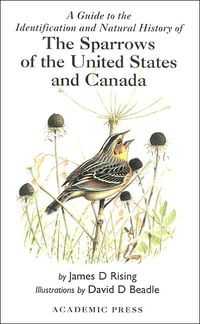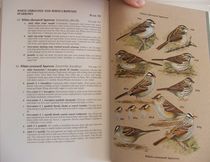Reviewed by Grant McCreary on March 2nd, 2008.
A cursory glance at the members of the sparrow family in North America reveals a multitude of small, drab birds. While it’s true that they are not brilliantly patterned like some other families, but those willing to look closer will be rewarded with a subtle beauty. The blue on the head of a Sage Sparrow and the green of a Henslow’s, for instance, are not garish but are nonetheless surprisingly extraordinary.
But some of these birds are fairly nondescript, and many look very much alike. Thus, this is one group of birds where a specialty guide such as this one is very helpful.
This is the first of two sparrow guides from these authors. For this review I’m going to be comparing this book to the follow-up – Sparrows of the United States and Canada: The Photographic Guide. Therefore, if you are not already familiar with it you should first read my review of the photo guide.
Illustrations
The main difference between the two is the type of illustrations. This book utilizes paintings by Beadle, while the second one uses photographs. Each species has anywhere from one to thirteen illustrations, with three to five being typical. The facing page contains the species name, the page number of its account, and a brief caption for each of the illustrations. The layout and look of the plates is reminiscent of a number of other family guides. The artwork is both accurate and pleasing to the eye.
Species Accounts
The species accounts here are very similar to the ones in the photo guide. In fact, the majority of the sections in each account are essentially identical. However, both versions do have some exclusive information.
Each account in this guide has the following which is not contained in the photographic guide:
- More detailed measurements and distribution
- Additional black and white drawings of the species at the beginning of each account
- Breeding Bird Survey relative abundance map
- History section – where it was first collected, and by whom; who it was named after, if applicable; other interesting notes
- Breeding section – describes nest, eggs, and incubation period
These sections are only included in the photo guide’s species accounts:
- Conservation status – population trends and threats
- Molt – what is molted (complete or partial), when, and where
- Hybrids – lists any that have been reported
Other Differences
The introductions of the two books overlap very little. This one includes an eight page introduction to sparrows as a whole, while the other has general ID tips, an overview of the sparrow genera, and four pages of habitat photos.
The photo guide includes a species not found here – the Yellow-throated Bunting. Additionally, it further splits the Fox Sparrow complex by treating the Thick-billed Fox Sparrow as a full species (to go along with the Sooty, Slate-colored, and Red Fox Sparrows).
Finally, the authors have made some aesthetic improvements in the follow-up photographic guide. It is slightly smaller and has better quality paper, better use of color, and bolded type in the accounts for important characteristics.
Recommendation
I would say that this is the best guide to North American sparrows that utilizes paintings, being slightly better than Sparrows and Buntings, by Byers, Curson, and Olsson. The artwork is very similar, but I think Beadle’s work here is slightly more appealing. Sparrows and Buntings does have more extensive text and also covers Europe, Africa, Asia, and some tropical species. But that additional material, along with the hardcover binding, makes it impractical to use in the field. The Rising book is also a little more up-to-date and has better range maps.
But how does it stack up against the photographic guide? They are both valuable references that I am glad to have. But as a practical matter most birders will probably want to choose one or the other, most likely based on the type of illustrations. For difficult groups of birds it is a good idea to have both types available. Thus, one possibility would be to employ the sparrow guide that is the opposite of your primary field guide. For instance, if you use The Sibley Guide, which is painted, then I would recommend the photographic sparrow guide.
However, the other differences should also be considered. The original guide includes more natural history and other information that makes it more valuable as a reference. The photographic guide, on the other hand, I have found more helpful for identification purposes.
If I had to choose only one, I would go with the photographic volume. The information exclusive to the initial book can be found elsewhere, but the extensive collection of superb photographs in the subsequent work is unmatched.
Disclosure: I get a small commission for purchases made through links in this post.






Thanks for the review. I really should get one of these guides. I still have a picture of a sparrow (taken in Yellowstone 2005) that I can not identify.